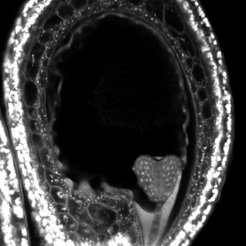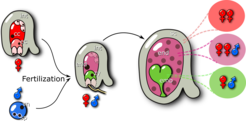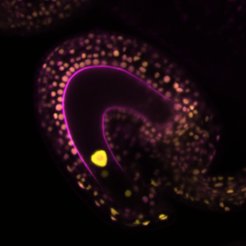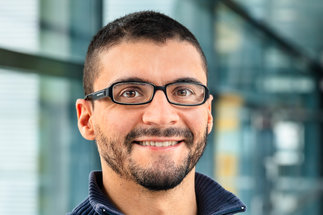Seed Development and Apomixis
The workgroup of Dr. Duarte Figueiredo studies seed development in flowering plants, with the aim of understanding the molecular mechanisms necessary for the formation of a viable endosperm and its surrounding seed coat. The group is particularly interested in the formation of apomictic seeds, which can form asexually, without requiring a paternal genome. For these purposes, the Figueiredo group relies heavily on genetics and molecular biology approaches, as well as on a variety of microscopy techniques.

An Arabidopsis seed showing the embryo at “heart” stage. The black region surrounding the embryo is the central vacuole of the endosperm.
A developing seed contains three structures: the embryo, which forms the next generation; the endosperm, which nourishes the embryo; and the seed coat, which protects the embryo and endosperm. The Figueiredo group is particularly interested in the development of the endosperm and of the seed coat. In most flowering plants, or angiosperms, the formation of these two structures is tightly linked to fertilization. This means that the paternal genome, carried by the pollen sperm cells, is necessary to trigger the development of the seed. However, some plant species, called apomicts, can develop seeds without requiring fertilization by the paternal sperm cells. Although apomixis has been known for many decades and while it holds a massive potential for agricultural applications, the molecular mechanisms that allow apomicts to produce asexual seeds is still vastly unknown.

The fertilization process in angiosperms. The pollen sperm cells (sp) fertilize two maternal gametes, egg cell (ec) and central cell (cc), forming the zygote (zy) and the endosperm (end). The zygote will grow into an embryo (emb) and will be nourished by the endosperm. These two structures are protected by the seed coat (sc), which develops from the ovule integuments (int). On the right-hand side can be seen the genetic composition of each seed structure.

Ovule of Arabidopsis showing an auxin biosensor, as imaged by confocal microscopy.
Remarkably, apomictic-like seeds can form in sexual species where the activity of the epigenetic regulators Polycomb Group proteins is affected. These proteins deposit an epigenetic repressive mark on DNA, H3K27me3, and without this mark the maternal ovules start producing endosperms and seed coats independently of fertilization. Previously we have shown that this apomictic-like phenotype correlates with an increased activity of the phytohormone auxin. In fact, by manipulating auxin homeostasis we can induce apomictic-like, or “autonomous”, development of the endosperm and of the seed coat in the model species Arabidopsis thaliana.
We are currently interested in the following research questions:
1. Is auxin activity a universal driver of endosperm and seed coat formation?
Our work in Arabidopsis shows that auxin is an important factor for endosperm and seed coat formation. But the question remains of whether this is also the case in other species. To test this, we are currently assessing whether the signalling pathways that we discovered in Arabidopsis are also present in other Angiosperms.
2. What additional pathways are required for endosperm and seed coat formation?
Although manipulation of auxin homeostasis allows us to produce apomictic-like endosperms and seed coats from unfertilized ovules, those structures do not reach the size of a fertilized seed. This means that there are additional factors that are required for the endosperm and the seed coat to develop properly. To uncover those pathways, we are exploring candidate pathways, as well as performing genetic screens using Arabidopsis as a model system.
3. Can we use this knowledge to engineer apomictic-like endosperm in crops?
Creating an apomictic endosperm is a major limitation for the introduction of apomixis into an agricultural setting. Thus, one of our goals is to select the most promising pathways and test whether we can use them to engineer an apomictic endosperm in crops.




